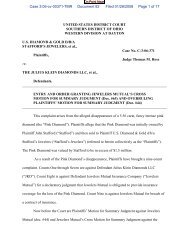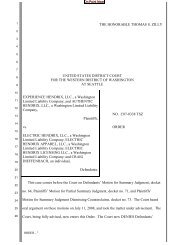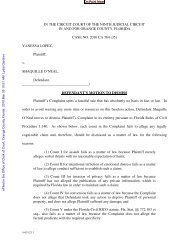GORDON KEENE VELLA. - On Point News
GORDON KEENE VELLA. - On Point News
GORDON KEENE VELLA. - On Point News
You also want an ePaper? Increase the reach of your titles
YUMPU automatically turns print PDFs into web optimized ePapers that Google loves.
ARGUMENT<br />
The Defendant has requested relief from judgment under Rule 60(b)(3) or, in the<br />
alternative, under Rule 60(b)(6).<br />
To prevail on a Rule 60(b)(3) motion, the moving party must show with clear and<br />
convincing evidence that the opposing party engaged in fraud, misrepresentation or misconduct<br />
that prevented the movant from fully and fairly presenting its case. 4<br />
Harley v. Zoeschi, 413 F.3d<br />
866 (8th Cir. 2005); Sellers v. Mineta, 350 F.3d 706 (8th Cir. 2003). See also In re Vioxx Prods.,<br />
489 F. Supp. 2d 587, 589 (E.D. La. 2007). Such relief is appropriate where material information<br />
has been withheld, or incorrect or perjured information has been intentionally supplied. Matter<br />
of Emergency Beacon Corp., 666 F.2d 754, 759 (2d Cir. 1981).<br />
Significantly, relief under subsection (b)(3) does not require the Court to find that “the<br />
information withheld be such that it can alter the outcome of the case.” Hesling v. CVX Transp.<br />
Inc., 396 F.3d 632, 641 (5th Cir. 2005). That onerous standard is reserved for instances<br />
involving allegations of misconduct “directed to the court itself, such as bribery of a judge or<br />
jury or fabrication of evidence by counsel.” Greiner v. City of Champlin, 152 F.3d 787, 789 (8th<br />
Cir. 1998). Rather, Rule 60(b)(3) is aimed at judgments that are unfairly obtained, and not<br />
necessarily at those that are factually incorrect. In re Vioxx, 489 F. Supp. 2d at 589 (ordering<br />
4<br />
In this Motion for relief, Vella is asserting that Dr. Daniel Brown made numerous and<br />
varied misrepresentations before this Court and before the jury. In reviewing the Rule 60(b)(3)<br />
Motion, the Court must find that misrepresentations where made; however, misrepresentation is<br />
rarely susceptible of direct proof. Under Nebraska law, proof of misrepresentation and the<br />
underlying intention to deceive can be established by circumstantial evidence and legitimate<br />
inferences arising therefrom, rather than direct evidence. Such inferences may be gathered from<br />
a chain of circumstances depending largely on the common sense knowledge of the motives and<br />
intention of men in like circumstances. Lincoln Ben. Life Co. v. Edwards, 45 F. Supp. 2d 722<br />
(D. Neb. 1999); Matter of Laursen, 214 B.R. 378 (D. Neb. 1997); Erickson v. Nat’l Trans. Safety<br />
Bd., 785 F.2d 285 (8th Cir. 1985); Jensen v. Sohler, 601 F.2d 353 (8th Cir. 1975); Rowe Intern.<br />
Inc. v. J-B Enter., Inc., 647 F.2d 830 (8th Cir. 1981).<br />
- 4 -
















